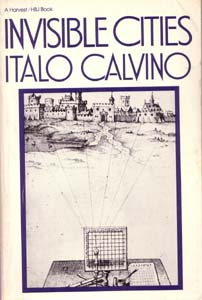| Ersilia (adapted from le
cittą e gli scambi. 4)
To keep the city from fraying,
they tie their homes together
using colour-coded threads,
commemorating birthdays,
kinships, honours, killer deals,
promotions, till the threads
take over and the occupants
pull down their houses, leaving
behind an empty fretwork.
Ersilia’s waifs pitch camp
across the valley and gaze
at the ghostly intricacies.
These are still their city.
They themselves are nothing.
They rebuild elsewhere, and
then again rebuild, shedding
exquisite filaments as they snail away.
See the desolations for yourself,
empty Ersilias, gaping walls,
the bones of the dead rolled
by the wind, the fine webs
yearning for a shape.
Smeraldina
(adapted from le
cittą e gli scambi. 5)
Welcome to the world's most liquid city.
Plash your way through interlaced canals,
or spice your crossing with a rise and fall
on ladders, galleries, mid-air pontoons
and humpy bridges, no two routes the same.
No one drops into the same rush hour twice.
Just nipping to the shops is an adventure.
But spare a thought for the clandestine, the intrepid,
who have the hardest time – as cats, cutpurses,
furtive lovers do in any city – inching
the gutters like rope-dancers, dropping
from penthouse to balcony, vertiginous,
circuitous …
and meanwhile down below
rats nose-to-tail it in the sewery dark,
slaloming with terrorists and drug mules
through air-vents and drains.
Up pops a head to scan the ground
as cheese rinds, Class As, acetone peroxide
shift from hidey hole to hidey hole,
boring a starburst of tunnels
through this watery town’s hard core.
To map all Smeraldina’s alleyways,
the liquid, solid, open and covert,
you’d need new colours:
infra-blue, ultra-vermillion, off the scale.
But this would be nothing
to pinning down the swallows’ highways.
See them slice the sky above the roofs,
undoing gravity,
jagging a pinnacle,
swerving to engulf a midge,
lords of the city in their airy avenues.
Zemrude
(adapted from le
cittą e gli occhi. 2)
The city is shaped by the watcher’s mood.
Whistling, with your nose abuzz,
you’ll know it by its way with light
(caged in its windows,
scatter-gunned by fountains)
and your heart will sashay
to bunting’s small hysteria.
Chin depressed on chest, nails scoring
your palms, your glance will scour the ground,
the gutters, manhole-covers, litter.
Which is truer? Skylights or detritus?
Every morning in Zemrude they can smell
the day before’s foul mood encrusted
at the foot of every wall.
The day will come for all of us. We’ll let
our gaze run down a drainpipe to the pavement,
and that’s where it will stick.
The opposite, though not impossible,
is rare. And so we tour Zemrude’s streets
with eyes that probe the questions slipped
between the paving stones, our pockets
dropping doubtful trails all over town.
|
Italo Calvino (1923-1985) was one
of Italy's foremost twentieth-century writers. His
early work was naturalistic and reflected his
socialist convictions, but he is best remembered now for
his wide-ranging and idiosyncratic fantasies. These three
poems are adaptations from Invisible
Cities, a set of prose
vignettes in which Marco Polo supposedly tells
Kublai Khan about the places he has visited on his
travels through the Mongol empire. 
|
![]()